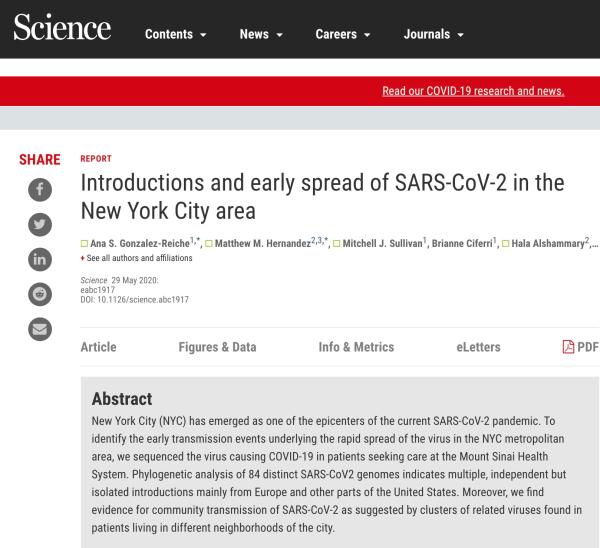The latest research shows that the new coronavirus in New York, the most severely affected area in the United States, was mainly introduced independently by Europe and America many times.
The above conclusions come from the research published by Mount Sinai Health System in the international authoritative journal Science on May 29th, local time. The study is titled “Introductions and early spread of SARS-CoV-2 in the New York City area”.


New York City has become one of the centers of the current SARS-CoV-2 pandemic. In order to determine the early rapid spread of the virus in New York City, the researchers genetically sequenced the virus of the new crown patient seeking treatment at Mount Sinai Health System. Phylogenetic analysis of 84 different SARS-CoV-2 genomes shows that New York’s new coronavirus mainly comes from multiple independent introductions in Europe and other parts of the United States. In addition, the researchers also found evidence of SARS-CoV-2 community transmission, which is related to the virus clusters found in patients living in different communities in the city.
The new coronavirus (SARS-CoV-2) is a new viral pathogen that has spread rapidly throughout the world in the past few months The pandemic was announced on March 11, 2020. The United States imposed travel restrictions on China on February 2, Iran on March 2, continental European countries on March 13, and the United Kingdom and Ireland on March 16, to prevent international import cases.
Despite these measures, New York State ’s first confirmed new crown case appeared in New York City on February 29. In the first few weeks of March, as the screening capabilities expanded, the number of new crown cases in New York increased rapidly. As of May 2, there were 312977 new crowns in New York StateDiagnosis cases, including 172,354 cases in New York City (accounting for 55% of New York State). New York City has become one of the major centers of SARS-CoV-2 infection in the United States, with more than 13,300 deaths in its metropolitan area.
The Pathogen Surveillance Project (PSP) at Icahn School of Medicine at Mount Sinai is a multidisciplinary, institutional infrastructure designed to produce high-resolution, near real-time Genetic information of pathogens, these pathogens come from a large number of diverse patients seeking treatment in the Mount Sinai health system in New York. Based on the next-generation sequencing technology of Illumina and Pacific Biosciences, PSP provides pathogen genome information through biological pecimen coding, nucleic acid extraction, and qPCR quantification.
Researchers used the existing PSP infrastructure to investigate the source of the SARS-CoV-2 strain spread in New York City and analyzed the population density of the virus Dissemination in metropolitan areas. The study showed the genomic diversity of 90 SARS-CoV-2 isolates from 84 patients seeking treatment in the Sinai Health System from February 29, 2020 to March 18, 2020.
These genomes indicate that in the first few weeks of March 2020, multiple independent sources introduced SARS-CoV-2 to New York City. Based on genetic similarity and phylogenetic analysis of full-length viral genome sequences, most cases diagnosed within 18 days of the first reported new crown case in New York State appear to be related to untracked transmission and potential travel-related exposure. It is worth noting that most of the virus introductions came from Europe and the United States. The researchers also identified two virus clusters with a total of 21 closely related cases, indicating that community transmission already exists.
These observations are also supported by the geographical distribution of these cases within the city, corresponding to 3 out of 4 administrative districts in New York City and 5 counties in New York State. The data shows that once SARS-CoV-2 is introduced from multiple independent sources and community transmission occurs, then restricting travel to New York has a limited effect on preventing transmission in metropolitan areas.
At the beginning of the outbreak, individuals must obtain the SARS-CoV-2 test to meet the US CDC ’s strict set of screening criteria and need to obtain approval from the local health department This is extremely restrictive for the New York City’s new crown test. From March 9th to March 14th, the situation changed, and the screening capacity of the New Crown Sinai Medical System (MSHS) in New York was greatly expanded, so the number of confirmed cases of the new crown surged. This week, every day